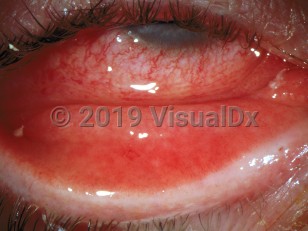Allergic conjunctivitis - External and Internal Eye
Alerts and Notices
Important News & Links
Synopsis

Typical symptoms of allergic conjunctivitis include swollen eyelids, mucoid discharge, and intense ocular itching. Itching is the most commonly reported symptom, and patients may also complain of a feeling of dirt or sand in the eyes. At times, the edema of the eyelids can be quite severe and be associated with scaling and fissure formation of the periocular skin.
Atopic keratoconjunctivitis (AKC), giant papillary conjunctivitis (GPC), and limbal and tarsal vernal keratoconjunctivitis (VKC) are rarer, more severe forms of allergic conjunctivitis. Although GPC may be recurrent, it does not carry as great a risk of long-term corneal damage and vision loss as AKC and VKC. People with other forms of atopic disease are more likely to develop AKC or VKC, often associated with atopic dermatitis and allergic rhinitis, respectively. Some of these forms of allergic conjunctivitis are discussed in more detail elsewhere; this writeup will focus on seasonal and perennial disease.
Codes
H10.10 – Acute atopic conjunctivitis, unspecified eye
H10.45 – Other chronic allergic conjunctivitis
SNOMEDCT:
473460002 – Allergic Conjunctivitis
Look For
Subscription Required
Diagnostic Pearls
Subscription Required
Differential Diagnosis & Pitfalls

Subscription Required
Best Tests
Subscription Required
Management Pearls
Subscription Required
Therapy
Subscription Required
Drug Reaction Data
Subscription Required
References
Subscription Required
Last Updated:02/16/2020
 Patient Information for Allergic conjunctivitis - External and Internal Eye
Patient Information for Allergic conjunctivitis - External and Internal Eye- Improve treatment compliance
- Reduce after-hours questions
- Increase patient engagement and satisfaction
- Written in clear, easy-to-understand language. No confusing jargon.
- Available in English and Spanish
- Print out or email directly to your patient


